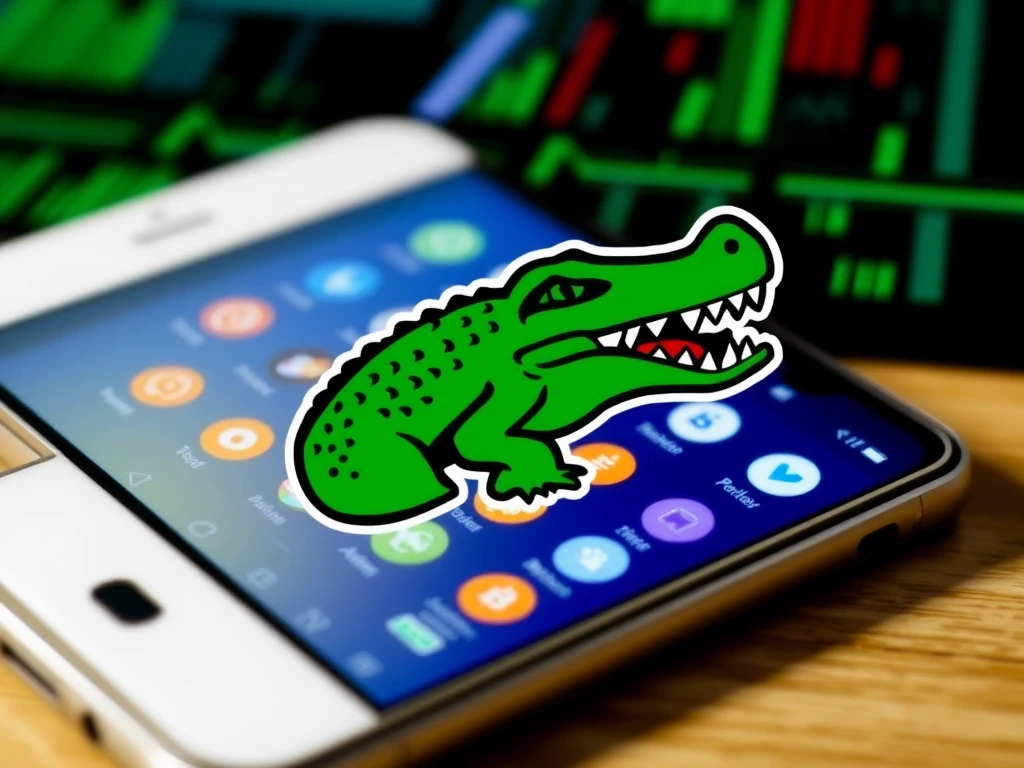Urgent: Crocodilus Malware – Dangerous Threat to Android Crypto Wallets

Are you an Android user holding cryptocurrency? If so, you need to be aware of a significant new threat: **Crocodilus malware**. This sophisticated virus is specifically designed to steal your digital assets, and it’s becoming increasingly prevalent. Understanding how it operates is the first step in protecting your valuable crypto holdings from this **malware attack**.
What is Crocodilus Malware?
Crocodilus is a dangerous Android Trojan identified in March 2025. Named for reptilian references hidden within its code, it targets Android 13 and later devices. Unlike simpler threats, Crocodilus doesn’t just rely on social engineering; it seeks deep integration and control over infected devices. Its primary goal? To drain your **Android crypto wallet**.
Discovered by fraud prevention experts at Threat Fabric, this malware uses a combination of techniques including screen overlays, remote access, keylogging, and even bypassing two-factor authentication to compromise your device and steal your funds. While initially focused on users in Spain and Turkey, experts predict its reach will soon expand globally.
How Crocodilus Malware Spreads and Infects
The primary infection vector for **Crocodilus malware** is still under investigation, but it likely follows common paths used by other mobile threats. It aims to trick users into granting it extensive permissions, particularly accessibility services, which allow it to monitor and control device functions.
Common ways this malware might find its way onto your phone include:
- Fake Apps: Disguising itself as legitimate crypto or utility apps on unofficial third-party app stores. While it has reportedly bypassed Google Play Store scanners, this is less common.
- SMS Phishing: Sending texts with malicious links that, when clicked, initiate the download or installation of the malware.
- Malicious Advertising: Embedded in online ads, often on less reputable websites, designed to trigger a download with a single tap.
- Email Phishing: Impersonating crypto exchanges or services in emails containing links or attachments that deploy the malware.
Once installed and granted accessibility permissions, Crocodilus connects to a command-and-control (C2) server. This allows attackers to remotely manipulate your device, display fake screens, record your actions, and ultimately access sensitive data like wallet credentials.
The Wallet Backup Trick: A Key Crocodilus Malware Tactic
One of the most insidious methods employed by **Crocodilus malware** is its deceptive wallet backup prompt. When you open your crypto wallet app, the malware can display a fake overlay designed to look like a legitimate system message. This overlay typically reads something alarming, like:
“Back up your wallet key in the settings within 12 hours. Otherwise, the app will be reset, and you may lose access to your wallet.”
If you tap “continue,” the malware then prompts you to enter your seed phrase or recovery key. Because Crocodilus utilizes keylogging, it captures everything you type. This gives the attackers the crucial information needed to import your wallet onto their own device and steal your assets. Remember, legitimate wallet apps will never ask for your seed phrase directly within a pop-up like this, especially not under a time constraint.
Beyond the Backup Trick: Full Device Compromise
The capabilities of **Crocodilus malware** extend far beyond just tricking you into revealing your seed phrase. This malware seeks complete control, making it a severe **malware attack** vector:
- 2FA Bypass: It can circumvent two-factor authentication by using screen recording to capture codes displayed by authenticator apps like Google Authenticator or codes received via SMS.
- Stealth Mode: To hide its activity, Crocodilus can display a black overlay on your screen and mute audio, making it appear as if your phone is off or locked while it operates in the background.
- Remote Control: Attackers gain extensive remote access, allowing them to open apps, activate the camera, record the screen, and execute various commands (up to 45 different types).
- SMS Control: It can read your text messages, send texts to your contacts, and even set itself as the default SMS application.
- Data Modification: The malware can alter or generate text to facilitate access to other private applications using information it has gathered from your device.
This level of intrusion highlights why a simple factory reset might not be sufficient to remove the threat, as it could potentially embed itself deeply within the system.
Spotting the Signs: How to Check for a Crocodilus Attack
While **Crocodilus malware** attempts to be stealthy, keeping an eye out for unusual activity can help you detect a potential infection and protect your **crypto wallet security**. Here are some signs to watch for:
- Unexplained App Activity: Check your device’s activity logs. Do you see your crypto or banking apps being accessed at times you weren’t using them?
- Suspicious Permissions: Regularly review the permissions granted to your apps, especially accessibility services. If an app you don’t recognize or trust has extensive permissions, investigate immediately.
- Increased Battery Drain: Malware running constantly in the background consumes power. A sudden, significant increase in battery drain without heavy usage could be a warning sign.
- Data Usage Spikes: Crocodilus transmits data to its C2 server. Monitor your mobile data usage; an unexpected spike could indicate background activity.
- Unusual Overlays or Prompts: Be extremely wary of unexpected pop-ups asking for sensitive information, especially seed phrases, even if they look legitimate.
What to Do If You’ve Fallen Victim to a Crocodilus Attack
Discovering you’ve been compromised by **Crocodilus malware** is alarming, but immediate action is crucial to mitigate damage. If you suspect an infection, follow these steps:
- Isolate the Device: Immediately disconnect the infected Android device from the internet (turn off Wi-Fi and mobile data). Turn the device off. If possible, remove the battery to ensure it’s completely shut down.
- Secure Your Assets: Use your securely stored, offline backup of your wallet’s seed phrase to recover your wallet on a clean, uncompromised device (like a computer or a different phone). Transfer your assets to a new, secure wallet address immediately.
- Avoid the Infected Device: Do not use the infected device for anything sensitive, especially accessing crypto wallets or banking apps. A factory reset may not be sufficient to remove this type of deep-integrating malware. Consider retiring the device or seeking professional help if you need to recover data.
- Report the Threat: If you believe the malware came from a specific app store or service, report the malicious app or link to the relevant platform (e.g., Google Play Store).
It’s a harsh reality that in the decentralized world, stolen crypto is almost impossible to recover without a central authority to intervene. This underscores the importance of robust **crypto wallet security** measures.
Preventing a Crocodilus Malware Infection: Bolstering Your Crypto Wallet Security
Prevention is always the best defense against **crypto scams** and malware like Crocodilus. As cybercriminals become more sophisticated, especially with threats like zero-click attacks, protecting your digital assets requires vigilance. Here are key practices to adopt:
- Download Apps Cautiously: Only download apps from the official Google Play Store. Even there, double-check the developer name, read reviews, and verify permissions requested before installing. Avoid third-party app stores entirely.
- Be Skeptical of Links and Attachments: Treat unexpected links in SMS messages or emails with extreme caution. Verify the sender’s identity independently before clicking anything.
- Use a Hardware Wallet: For storing significant amounts of cryptocurrency, a hardware wallet is highly recommended. These devices keep your private keys offline, making them immune to malware on your phone or computer.
- Review App Permissions Regularly: Periodically check which apps have access to sensitive permissions, especially accessibility services, SMS, and storage. Revoke permissions for apps that don’t legitimately need them.
- Keep Software Updated: Ensure your Android operating system and all apps are kept up to date. Updates often include security patches that protect against known vulnerabilities.
- Install a Reputable Security App: Use a well-known and trusted mobile security application that can scan for and detect malware.
- Stay Informed: Follow reputable cybersecurity news sources and crypto security experts to stay aware of new threats like Crocodilus.
Being proactive about your digital hygiene is paramount in protecting your **Android crypto wallet** from dangerous threats like Crocodilus malware. Don’t wait until you’re a victim; implement strong security practices today.
Conclusion
The emergence of **Crocodilus malware** is a stark reminder of the evolving threats targeting cryptocurrency users on mobile devices. Its ability to bypass 2FA, record screens, and trick users with sophisticated overlays makes it particularly dangerous. By understanding its methods, recognizing the signs of infection, and implementing strong **crypto wallet security** practices — including cautious app downloads, skepticism towards unsolicited links, and considering hardware wallets — you can significantly reduce your risk of falling victim to this and other **crypto scams**. Stay vigilant, stay informed, and protect your digital wealth.







